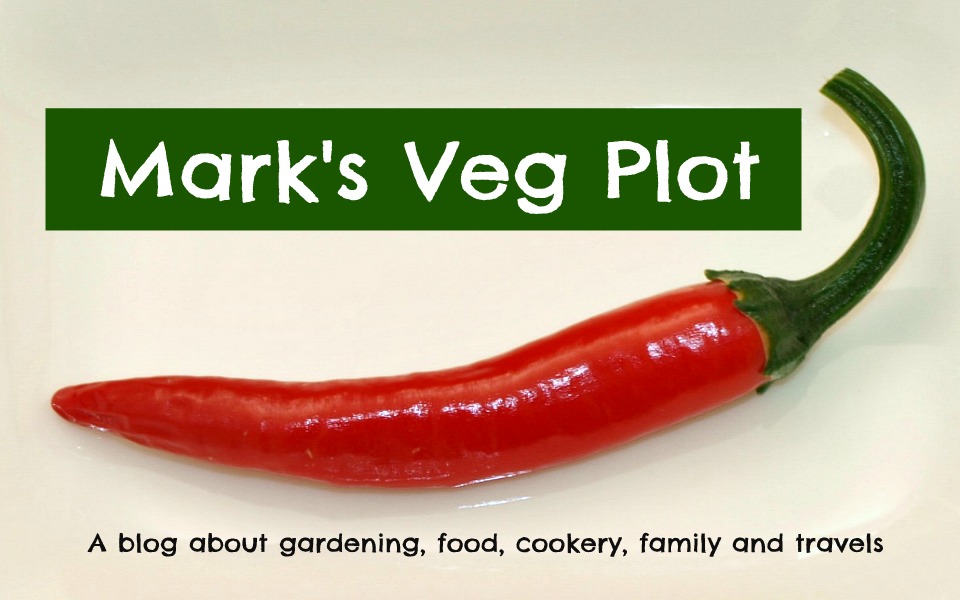Last year for the first time I grew some Borlotto beans for drying. In the past I have eaten them for their pods, like Runner beans. Having kept these beans for a few months now - successfully resisting the strong temptation to cook them - I now feel that the time has come for them to be put to use...
Whilst harvesting the beans I found one pod containing seeds of a much darker colour than all the rest. I thought this might be fairly unusual, so I decided to keep those ones aside and sow them this coming season to see if I can produce more of them. There were only five:
Here you can see the big difference between the few dark beans and the other "normal" Borlotti
Most of the beans are not going to be sown, but eaten. We have just bought a new book about beans, called "Heirloom Beans" by Steve Sando and Vanessa Barrington. Steve Sando runs Rancho Gordo, a business in California which supplies vegetables to Thomas Keller's highly acclaimed restaurant The French Laundry (winner in the past of the "Best restaurant in the world" award.).
This book is packed with hugely-inspirational recipes for cooking different types of bean. In fact the book describes 50 types of heirloom bean. It is illustrated with some fabulous photos by Sara Remington. The book is basically a recipe book, so the emphasis is on the dried beans as ingredients, and on the dishes you can make with them. It is not a gardening book, though I suspect that most veg gardeners are (like me) Foodies too, and this book will probably appeal to them as well.
I'll write about some of the recipes from the book in due course...
By the way, look closely at the cover of that book, at the left-hand picture. You will see a couple of very dark Borlotto beans surrounded by a lot of creamy-coloured ones. So my dark ones are not a unique new variety after all. (Rats! I thought I was going to be famous for discovering "Borlotto Marksvegplotii")...

In the States they often call Borlottis "Cranberry Beans". It's more understandable when you see these darker beans.
ReplyDeleteI had a similar variation with mine
http://malsallotment.blogspot.com/search?updated-min=2010-01-01T00%3A00%3A00-08%3A00&updated-max=2011-01-01T00%3A00%3A00-08%3A00&max-results=50
and I've saved them too. So let's compare notes this autumn!
I have also had variations with beans that I have grown.
ReplyDeleteDry beans are so pretty and there are so many different varieties to grow!
Love the latin Mark, if you like I'll start using it to refer to darker beans and hopefully it will catch on over here :)
ReplyDeleteThe beans look like they dried really well, where and how did you keep them?
Unrelated to this post - but, pretty beans, I want some! - I owe you a reply. I've been back to the UK and running around campaigning etc, mostly without the internet, but for some reason none of your follow options showed up last time, anyway, you will see I am now a dedicated follower of your blog, as promised!
ReplyDeleteHaving turned a little away from meat, we are eating lots of beans and pulses. They are such a versatile ingredient. I will be interested to see your recipes. I have planted some bush borlotti (because the bloody snalis got the first lot of 'Cooks Magic Mix'. Do I leave them on the bush to dry, or pick and dry them?
ReplyDeleteI'd love to hear how your bean experiment goes. I got some Borlotti beans in a seed trade. I've never grown dried beans so I'm excited to try them this season. I can't wait to see how you cook them!
ReplyDeleteIt will be a fine experiment to see how many colour variation will you get from these beans.
ReplyDeleteI have also find color variations in my beans. I think it happens more often than we think.
ReplyDeleteUnlike you, I saved all my dry bean harvest for seed. It wasn't much, for one meal maybe. This year I hope to have more.
Beans can be really attractive which is why when I was a primary teacher we used beans and pulses in art work! You can learn a lot about design from nature!
ReplyDeleteDad, have your heard of Darya Pino at Summer Tomato? (http://summertomato.com/). Hers is one of my favourite blogs and she often writes about buying beans from Rancho Gordo at the San Francisco farmer's market. It was her writings about beans that made me stop buying tinned ones and start cooking my own, and I've never looked back. I Highly recommend her blog!
ReplyDeleteThey look almost too good to eat. Sorry you are apparently not about to become a famous bean name. Book looks interesting. So many books, so little time...
ReplyDeleteWhen I saw the picture I thought it might be the answer to the mystery beans I have been given to grow. Mine are dark and mottled like your dark and mottled one but rounder.
ReplyDeleteEsther
Thanks to everyone for their encouraging comments about the beans. I'll sow the dark ones in a couple of months' time, when the weather warms up, and I'll let you know how they perform. I hope they will "come true" and produce loads more dark beans. My total harvest of dried beans last year was not huge - one large jam-jar full - but as I keep telling myself, quality is more important than quantity. In the Heirloom Beans book it advises you not to store Borlotti for more than a year, as they deteriorate quicker than many other types. I have kept mine in a dark cupboard, which I hope has assisted a bit. (See my post called "Variations on a Bean" from 28 October for more pics).
ReplyDelete